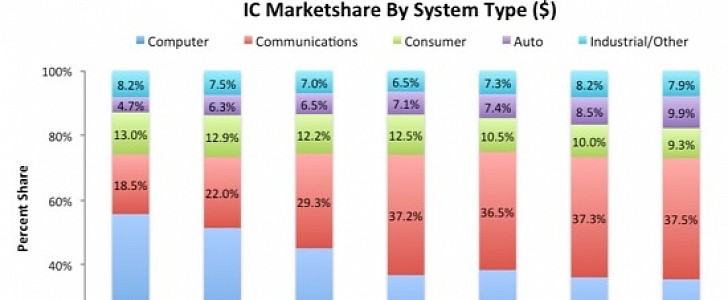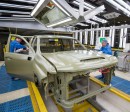The automotive world is battling a fierce chip crisis, and according to the latest forecasts, the constrained inventory would continue to be a problem until 2023, or even worse, until 2024 for some companies.
While everybody in the industry is working on addressing the shortage, analysts explain that chips continue to be in strong demand in the automotive market because of investments in electric vehicles and smarter cars.
The reason is as simple as it could be: these vehicles come with more advanced systems, which in their turn require more chips. In other words, building a new-generation car requires a bigger number of chips, and this is why foundries are working non-stop on filling their orders for the automotive market.
Recent research conducted by IC Insights shows that the market share for chips destined for the automotive market has improved substantially since 1998. In fact, it’s actually expected to double by 2026, as it should get close to the 10 percent milestone.
While the computer sector continues to dominate the chip industry, its share has declined substantially since 1998, going down from 55.6 percent to an estimated 35.4 percent in 2026.
This is primarily the result of investments in other key sectors, such as communications (where the share is growing from 18.5 percent in 1998 to an estimated 37.5 percent in four years) and the automotive market.
Back in 1998, the car market accounted for just 4.7 percent of the chip industry, but the share gradually increased to reach 7.4 percent last year. IC Insights believes the numbers will continue to grow before they eventually reach 9.9 percent in 2026.
Of course, these are only estimates, but at the end of the day, they make a lot of sense. Carmakers are investing big in new-generation capabilities in their cars, and the only thing that’s blocking them from bringing more units to customers is the painful shortage that’s wreaking havoc on their operations.
The reason is as simple as it could be: these vehicles come with more advanced systems, which in their turn require more chips. In other words, building a new-generation car requires a bigger number of chips, and this is why foundries are working non-stop on filling their orders for the automotive market.
Recent research conducted by IC Insights shows that the market share for chips destined for the automotive market has improved substantially since 1998. In fact, it’s actually expected to double by 2026, as it should get close to the 10 percent milestone.
While the computer sector continues to dominate the chip industry, its share has declined substantially since 1998, going down from 55.6 percent to an estimated 35.4 percent in 2026.
This is primarily the result of investments in other key sectors, such as communications (where the share is growing from 18.5 percent in 1998 to an estimated 37.5 percent in four years) and the automotive market.
Back in 1998, the car market accounted for just 4.7 percent of the chip industry, but the share gradually increased to reach 7.4 percent last year. IC Insights believes the numbers will continue to grow before they eventually reach 9.9 percent in 2026.
Of course, these are only estimates, but at the end of the day, they make a lot of sense. Carmakers are investing big in new-generation capabilities in their cars, and the only thing that’s blocking them from bringing more units to customers is the painful shortage that’s wreaking havoc on their operations.






